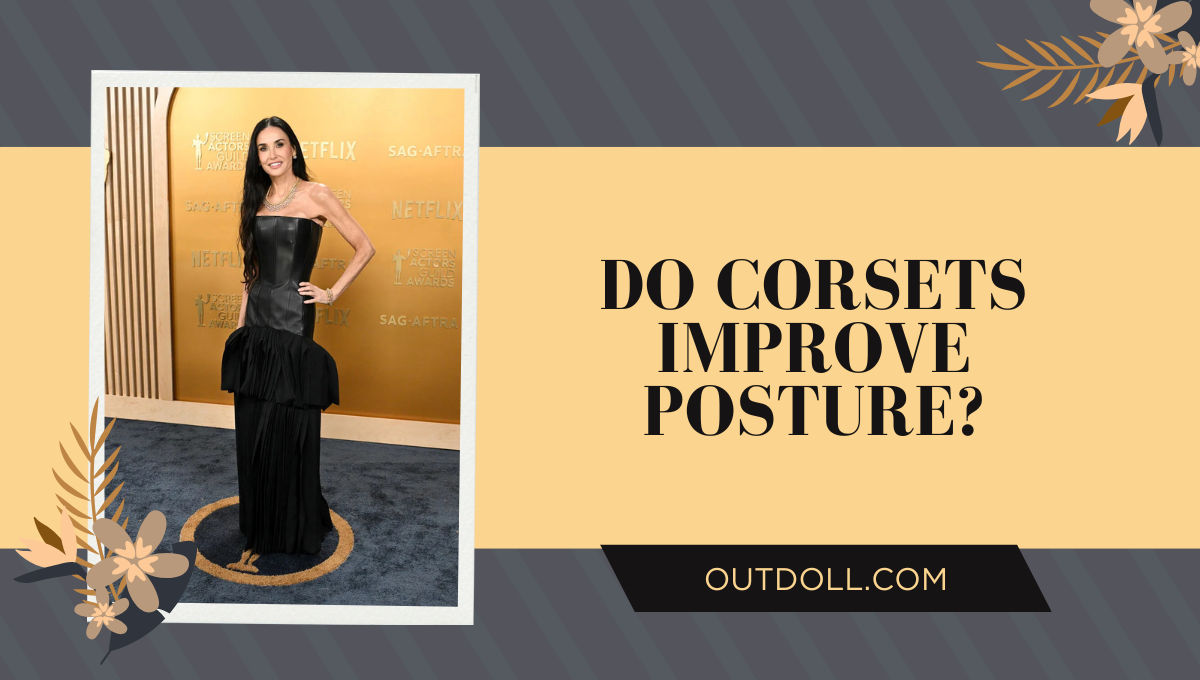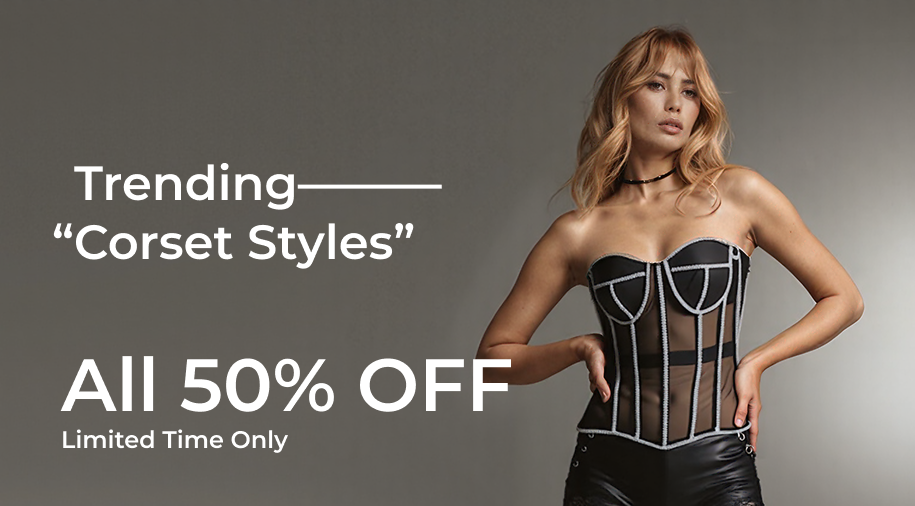Do Corsets Improve Posture? Benefits, Risks & Tips

For centuries, corsets have carried a reputation not only as fashion pieces but also as tools that shape the body and correct posture. Many believe these structured garments are posture-correcting aids, offering the kind of support that keeps your back straight and your shoulders pulled back. But the big question remains: do corsets improve posture, or is this benefit overstated?
On the surface, corsets seem like an easy fix. Their rigid boning and firm lacing create a structured frame that encourages wearers to sit and stand taller. This has made them popular among those looking for quick solutions to slouching or back strain. However, posture correction is more complex than simply holding the body upright with external support.
While corsets can deliver short-term improvements, such as reducing slouching and encouraging awareness of body alignment, experts caution that overreliance may weaken core muscles in the long run. To truly understand whether corsets are beneficial or harmful, it’s important to look at both the immediate effects and the potential long-term consequences.
What Is a Corset & Its Link to Posture?
Corsets have long been admired for their ability to shape the body and create an elegant silhouette, but many also credit them with improving posture. These garments combine structural support with compression, giving the wearer a straighter stance and reduced slouching. While this effect can be noticeable, it’s largely temporary and depends on how the corset is worn, its design, and the wearer’s muscle engagement. Understanding how corsets affect posture requires examining both their supportive features and their limitations.
How Corsets Provide Support?
The structure of a corset is reinforced with boning, panels, and tight lacing that compress the torso. This design limits forward bending and encourages the spine to stay aligned. When worn correctly, it can act as a physical reminder to maintain an upright position, making wearers more aware of their posture throughout the day.
Limitations of Corset Posture Support
While corsets may temporarily straighten the back, they do not strengthen the muscles responsible for maintaining posture naturally. Relying too much on external support can reduce core engagement over time, and posture improvements often vanish once the corset is removed. Long-term alignment depends on muscle strength, flexibility, and proper spinal health rather than external compression alone.
Short-Term Posture Benefits
Wearing a corset can produce noticeable changes in how you hold your body almost immediately. Many users report that the structured support of a corset makes it easier to stand and sit upright, creating a sense of stability and confidence. These benefits, however, are mostly temporary and last only while the garment is being worn. In other words, corsets improve posture temporarily rather than offering a permanent solution.
Upright Support
The rigid boning and tight lacing of a corset naturally hold the torso in an upright position. This encourages wearers to stand tall and maintain a straighter spine, which can be particularly helpful during long periods of sitting or standing.
Reduced Slouching
By restricting excessive forward bending, corsets act as a physical reminder to avoid slouching. Users often notice they stay more aligned and less likely to hunch over desks, phones, or workstations.
Posture Awareness
Wearing a corset can heighten body awareness. The compression and structure signal when the body shifts out of proper alignment, prompting adjustments that help maintain better posture during the period of use.
Core Engagement Reminder
Although corsets provide external support, they also encourage subtle activation of the abdominal and back muscles. This reminder can help wearers practice maintaining alignment even when removing the corset later.
Confidence & Poise
Standing or sitting straighter can improve overall confidence and presence. Many users report feeling more poised, which positively affects body language and can even enhance professional or social interactions while wearing the corset.
Risks & Long-Term Effects on Posture
While the immediate effects of corsets may feel beneficial, experts caution against relying on them for long-term posture correction. Extended or frequent use can create negative consequences, as the body may become dependent on external support. Many question whether do corsets really improve posture long term, and research suggests that they do not.
Weakening Core Muscles
Corsets provide external support that reduces the need for your abdominal and back muscles to engage fully. Over time, this can lead to muscle weakening, as the body relies on the garment instead of building natural strength. A weaker core may worsen posture once the corset is removed.
Spinal Alignment Concerns
Incorrectly fitted or overused corsets can push the spine into unnatural positions. This may cause discomfort, tension, or even long-term alignment issues, particularly if worn too tightly or for prolonged periods.
Breathing & Comfort Issues
Tight compression around the torso can limit lung expansion, making deep breathing more difficult. Over time, this restriction can affect stamina and comfort, discouraging consistent wear or proper posture when the corset is off.
Digestive & Organ Pressure
Prolonged corset use can place pressure on internal organs, leading to issues such as acid reflux, bloating, or mild digestive discomfort. The effect is more pronounced if the corset is excessively tight or worn immediately after meals.
Circulation Limitations
Excessive compression may impair blood flow in the midsection, causing numbness, tingling, or cold sensations in the torso or lower extremities. Maintaining healthy circulation is critical, so extended wear should be avoided.
Psychological Dependency
Relying on a corset for posture can create a mental habit where wearers feel unable to maintain proper alignment without it. This dependency may prevent the development of natural posture habits through exercise or conscious effort.
Corsets vs Exercise & Therapy
While corsets can provide temporary support, long-term posture improvement is more effectively achieved through targeted exercises and professional guidance. Comparing corset posture correction vs exercise highlights the differences between external support and active body strengthening. Exercise, therapy, and posture tools engage muscles naturally, leading to sustainable alignment without dependency.
Core Strengthening
Engaging the abdominal and lower back muscles through planks, Pilates, or yoga improves spinal support. Unlike corsets, these exercises build strength that maintains posture naturally, even when no external support is worn.
Physical Therapy Approaches
Physical therapists can design individualized plans to correct posture imbalances. These may include stretching, strengthening, and ergonomic guidance—methods that reduce the risk of injury and promote long-term spinal health.
Posture Training Tools
Posture correctors, ergonomic chairs, and wearable sensors provide reminders to sit or stand upright. These tools support proper alignment without over-relying on restrictive garments like corsets.
Flexibility & Mobility Exercises
Maintaining spinal flexibility and shoulder mobility complements strength training. Stretching routines, foam rolling, and mobility drills reduce stiffness, helping the body maintain upright alignment more comfortably than a corset alone.
Habit Formation & Mindful Posture
Regular awareness practices, such as mindful sitting, standing, and walking, reinforce posture habits. Over time, these mental cues create sustainable improvements that external compression garments cannot provide.
Best Practices for Safe Use
Corsets can provide temporary posture support, but improper use can lead to discomfort or long-term issues. Understanding how to wear a corset wisely ensures you get benefits while minimizing risks. For those wondering if a corset improves posture, combining proper use with exercises and awareness is key to maintaining safe alignment.
Limit Wear Time
Avoid wearing a corset for long periods. Limit use to 1–2 hours at a time, especially during activities requiring upright posture. Overuse can weaken your core muscles and lead to reliance on external support rather than natural strength.
Choose Proper Fit
Selecting the right size is crucial. A corset that is too tight can restrict breathing and circulation, while one that’s too loose provides little support. Proper sizing ensures comfort, correct posture alignment, and prevents strain on your back or ribs.
Pair with Exercise
Corsets should complement core-strengthening and back exercises rather than replace them. Exercises like planks, Pilates, and yoga actively engage muscles needed for good posture. This combination improves posture naturally and helps maintain alignment when the corset is removed.
When to Avoid?
Avoid corsets if you are pregnant, recovering from abdominal surgery, or have breathing or spine issues. In these cases, exercises, posture training, and professional guidance offer safer, long-term benefits without the risks of compression garments.
Adjust Gradually
Start with light compression and gradually increase as your body adapts. Sudden or excessive tightening can strain muscles, organs, or the spine. Gradual adjustment allows your body to get used to support while minimizing discomfort.
Maintain Awareness
Even when wearing a corset, actively monitor your posture. Treat the garment as a reminder, not a crutch. Regularly checking alignment helps reinforce long-term posture habits beyond temporary support.
Choose Quality Materials
Invest in corsets made from breathable, flexible fabrics with sturdy boning. High-quality materials reduce discomfort, prevent skin irritation, and ensure consistent support, unlike cheap or rigid alternatives that can cause pain.
Listen to Your Body
Pay attention to signs of discomfort, numbness, or pain. Removing the corset promptly prevents injury and encourages safe posture practices. Your body should always guide the limits of corset use.
Who Should Avoid Corsets?
While corsets can offer temporary posture support, they are not suitable for everyone. Certain medical conditions, physical limitations, or life stages can make wearing a corset risky. Understanding who should avoid these garments is crucial for safety and long-term health.
Pregnancy & Postpartum
Corsets are not recommended during pregnancy, as tight compression can restrict the growing abdomen and affect blood flow. Postpartum, abdominal and core muscles are still recovering, and wearing a corset too early may interfere with healing and proper alignment.
Post-Surgery Patients
Individuals recovering from abdominal, back, or chest surgery should avoid corsets. Compression can interfere with stitches, surgical healing, and increase the risk of pain or complications. Always consult a medical professional before considering any compression garment.
Respiratory or Core Issues
People with respiratory problems, weakened core muscles, or spinal conditions should skip corsets. Tight garments may restrict breathing, increase strain on already weak muscles, and worsen posture issues instead of improving them. In such cases, targeted exercise and physical therapy are safer alternatives.
Other Medical Conditions
Conditions like hernias, acid reflux, or circulatory problems can be aggravated by corset compression. Those with chronic pain or orthopedic concerns should prioritize professional advice over temporary posture solutions.
Age Considerations
Young teenagers whose skeletal structure is still developing and older adults with bone or joint issues should avoid tight corsets. Natural growth and flexibility are important, and restrictive garments can hinder proper development or movement.
FAQs
Do corsets improve posture permanently?
Corsets provide immediate support and help you maintain a straighter stance while wearing them. However, they do not train muscles or correct spinal alignment long-term. For lasting benefits, strength exercises and posture training are essential.
Can I wear a corset daily for posture?
Wearing a corset every day is not recommended. While it can temporarily improve posture, overuse may weaken core muscles and create dependency. Use it only for short intervals alongside exercise.
Are corsets safe for back pain?
Corsets may offer temporary relief by supporting the back, but they are not a cure for chronic pain. Individuals with existing back conditions should consult a healthcare professional before relying on a corset for posture support.
Do corsets replace exercise for posture?
No. While a corset improves posture temporarily, it cannot replace the muscle engagement that comes from core-strengthening exercises. Combining corset use with targeted workouts ensures safer, long-term results.
How long should I wear a corset?
Short periods are safest—typically 1–2 hours at a time. Wearing a corset longer than recommended can lead to discomfort, restricted breathing, or muscle weakening, reducing its overall effectiveness.
Can corsets improve posture for beginners?
Beginners may notice immediate upright support and reduced slouching. However, these effects are temporary, and proper posture habits should be built through exercise and mindful alignment over time.
Are all corsets effective for posture correction?
Not all corsets are designed for posture support. Some are purely aesthetic, while others offer structured boning and compression. Choosing a quality corset and using it responsibly is essential for any posture benefit.
Final Verdict
Corsets can provide immediate posture support, helping you stand taller, reduce slouching, and increase body awareness. However, these effects are temporary, and relying solely on a corset is not a substitute for core strengthening, exercise, or professional posture training. For safe use, choose a properly fitted corset, limit wear time, and pair it with posture-focused workouts. People with medical conditions, pregnancy, or recent surgery should avoid corsets and consult a professional. Ultimately, a corset can be a helpful tool for short-term alignment and fashion, but lasting posture improvement comes from strengthening your muscles and practicing mindful alignment daily.


